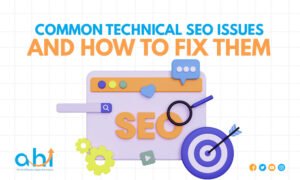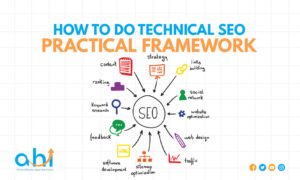Creating high-quality content alone does not cut it in digital marketing. Once you optimize your website to be visible to your audience, you can put your website to be forgotten. This is where technical SEO helps. Certainly, it helps for engines to crawl your website, index it, and understand your website. In other words, it helps your website be visible and ranked. For any business or website owner aiming for long-term value, enough value is in understanding what is and how technical SEO works and why it matters.
Having experience in advanced technical SEO, and SEO audit consultancy where I helped businesses, I understand how impactful small technical issues can be to your SEO rankings. This guide will take you from the basic technical SEO audit and will help you with advanced tips, tools, and strategies.
What Is Technical SEO?
Technical SEO is the part of SEO which optimizes the website’s hidden system. It helps the search engines crawl your site, references index, and ranks the content. Technical SEO does not work with content creation or audience engagement like on-page or off-page SEO. It is concerned with the site’s performance, security, and overall structure.
Improving the technical side of your website means laying a better foundation to help build your content and links. Some of the most important areas are:
- Website Crawlability and Indexation: Making sure your pages are reachable.
- Site Speed and Core Web Vitals: Improving the load time, LCP, CLS, and INP.
- Mobile Friendliness: Complying with Google’s mobile-first indexing.
- Security: Using HTTPS and secure protocols.
- Structured Data and Schema: Helping search engines get the context of your pages.
By addressing these factors, technical SEO issues like broken links, duplicate content, or slow pages are minimized, creating a strong foundation for higher rankings.
Google Search Console, Screaming Frog, and SEMrush are great tools to get a proper technical SEO audit.
Why Is Technical SEO Important?
Having a website with technical SEO means your pages are fast, secure, and easy to crawl. This all directly impacts search engine rankings, user experience, and the growth of organic traffic.
In 2025, search engines will prioritize not only the quality of content, but also the experience and performance of the website. Here is why technical SEO for WordPress and other platforms is important:
- Improved Search Engine Crawl Efficiency: Helps avoid missed pages and indexing issues.
- Increased Page Load Speed: Quicker pages improve user engagement and decrease bounce rate.
- Improved Mobile Optimization: Websites that are mobile-friendly are ranked higher in Google’s mobile-first index.
- Let’s look at the raw facts: Fixed redirect chains, 404s, and broken links improve site health.
- Let’s delve deeper: Proper site architecture and the use of structured data afford your content the opportunity to appear in rich results and featured snippets.
Ignoring technical SEO tips can cause even the best content to underperform in search results.

The Benefits of Technical SEO
- Higher Search Rankings: Websites with optimized structure and performance rank better.
- Better User Experience: Fast, secure, and mobile-friendly sites retain visitors.
- Increased Organic Traffic: Efficient crawling and indexing ensure more pages rank.
- Improved ROI: Fewer technical issues mean less spending on corrections and more sustainable growth.
- Enhanced Compatibility with AI Search: Technical SEO ensures your site works with AI-powered search engines and voice search.
Pro Tip: Missing even fundamental, basic elements like canonical tags houses slow-loading images, reinforcing the need for regular technical SEO audits to rectify the problems and maintain the health of your site.
Technical SEO Audit: The First Step Toward Optimization
A technical SEO audit prioritizes the unresolved problems of your website regarding its technical health, determining elements restricting crawlability, indexation and rank. This is the first step of focused improvements.
An effective technical SEO audit involves:
- Crawl Analysis: Look for and fix problems found in Google Search Console and your crawl tools.
- Site Performance Analysis: Evaluate Core Web Vitals, page speeds, and server response times.
- Mobile and User Experience Testing: Diagnose for mobile usability and navigational ease.
- Security Checks: Determine if data privacy, HTTPS, and SSL certificates are in place and functioning as they should.
- Content Structure Analysis: Assess work regarding canonical tags, meta tags, schema markup, and internal linking.
- Technical SEO Tools: Screaming Frog, Sitebulb, Ahrefs, and SEMrush are just a few examples that allow for technical SEO automation.
For businesses, hiring technical SEO audit consultancy services can save time and provide advanced insights for enterprise-level optimization.
Technical SEO Checklist: Step-by-Step Guide
A comprehensive technical SEO checklist makes sure no part of your website’s technical health is missed. The following steps should be taken to improve crawlability, indexation, and website performance as a whole.
- Site Crawl & Indexation
- Ensure all important pages are indexable.
- Use robots.txt to block irrelevant pages.
- Check noindex/nofollow tags for correctness.
- Monitor Google Search Console for crawl errors.
- HTTPS & Site Security
- Switch to HTTPS to secure your website.
- Install valid SSL certificates.
- Avoid mixed content issues that affect ranking.
- Mobile-Friendliness
- Use responsive design for all devices.
- Test with Google’s Mobile-Friendly Test.
- Optimize buttons, navigation, and font sizes for mobile users.
- Page Speed Optimization (Core Web Vitals)
- Reduce the time it takes to display the most important pieces of content (Largest Contentful Paint, LCP).
- Focus on minimizing the shift of content (Cumulative Layout Shift, CLS).
- Work on the speed of interactions and subsequent painting of the display (Interaction to Next Paint, INP).
- Optimize images, set up caching with dynamic content, and configure a Content Delivery Network (CDN).
- URL Structure & Canonical Tags
- Short and readable URLs with relevant keywords will be appreciated.
- Reduce duplicate content by using canonical tags.
- Keep a consistent hierarchy of your URLs.
- XML Sitemap & Robots.txt
- Provide an up-to-date XML sitemap to search engines.
- Your robots.txt should only block unnecessary pages.
- The sitemap should have no broken or redirected URLs.
- Internal Linking & Navigation
- Establish a clear site structure.
- Use anchor texts that are descriptive and relevant.
- Regularly link important pages to enhance the SEO value.
- Fixing 404 Errors & Redirects
- Find and repair broken links.
- Use 301 redirects to reroute users and avoid broken links, and related loops or chains.
- Structured Data / Schema Markup
- Include schema markup for your products, articles, FAQ and events.
- It will help search engines understand your content and show rich results.
- Image Optimization
- Optimize images by keeping their quality after compression.
- Use descriptive keywords in your ALT tags.
- Use lazy loading so pages can load faster.

Common Technical SEO Issues and How to Fix Them
Most websites deal with technical SEO issues such as broken links, slow loading pages, duplicate content, and missing schema. Fixing these problems leads to better crawlability, indexation, user experience, and improved rankings on search engines.
- Issues with Crawls:
- Identify issues with Google Search Console.
- Fix broken links, 404 pages, and blocked resources.
- Duplicate Content:
- Use canonical tags to indicate the preferred version.
- Avoid publishing identical content across multiple URLs.
- Redirect Chains & Loops:
- Simplify redirects; avoid multiple hops.
- Use 301 redirects for permanent URL changes.
- Slow Loading Pages:
- Compress images, minify CSS/JS, and enable caching.
- Test with PageSpeed Insights and GTmetrix.
- Heavy JavaScript Impact:
- Ensure important content loads without blocking.
- Consider server-side rendering or dynamic rendering.
- Missing Structured Data:
- Implement schema markup for rich results.
- Use Google’s Rich Results Test to validate.
- Problems with Mobile Optimization:
- Ensure responsive design, legible fonts, and accessible navigation.
- Test responsive design with Google Mobile-Friendly Tool.
By fixing technical SEO issues, you can improve user experience, make your site better for search engines and gain an advantage over your competitors.
Top Technical SEO Tools (Free & Paid)
Using the right technical SEO tools helps identify, analyze, and fix issues efficiently.
- Google Search Console: For documenting crawl errors, indexing, and mobile usability, use Google Search Console.
- Screaming Frog: For in-depth site crawling and technical audits, use Screaming Frog.
- Sitebulb: Use Sitebulb to obtain visual site audits along with actionable insights.
- Ahrefs Site Audit: For broken link and performance, security issue audits use Ahrefs Site Audit.
- SEMrush: Use SEMrush for comprehensive site audit, competitive analysis, and to obtain health score.
- Google PageSpeed Insights & Lighthouse: Use Google PageSpeed Insights in conjunction with Lighthouse to analyze page speed, Core Web Vitals, and accessibility.
- GTmetrix: For performance analysis use GTmetrix. It provides detailed performance reports and recommendations.
Pro Tip: Using different tools helps to cross verify and understand your website’s technical health more clearly.
Advanced Technical SEO Techniques
Advanced technical SEO focuses on optimizing site architecture, structured data, Core Web Vitals, and server performance to maximize search engine rankings and user experience.
- Structured Data & Schema:
- Implement FAQ, Article, Product, and Event schemas.
- Enhances visibility in rich results.
- Core Web Vitals Optimization:
- Improve LCP, CLS, INP for better UX and ranking.
- Use tools like PageSpeed Insights and Web Vitals extension.
- Server-Side Rendering (SSR) & Lazy Loading:
- SSR improves JavaScript SEO for dynamic websites.
- Lazy loading reduces initial load times for images/videos.
- JavaScript SEO & Dynamic Rendering:
- Ensure critical content is rendered for crawlers.
- Avoid content hidden behind complex scripts.
- Log File Analysis:
- Study crawl behavior of search engines.
- Identify high-priority pages and potential bottlenecks.
- Technical SEO for WordPress:
- Use lightweight themes, update plugins, and implement caching.
- Use SEO plugins like Yoast or Rank Math for advanced optimizations.

How to Do Technical SEO: Practical Framework
To do technical SEO effectively, start with a comprehensive audit, prioritize issues based on impact, implement fixes systematically, and monitor performance regularly to maintain optimal website health and search rankings.
- Step 1: Conduct a Technical SEO Audit
- Use Screaming Frog, Sitebulb, or SEMrush to crawl your website.
- Check for crawl errors, broken links, duplicate content, and indexing issues.
- Review Core Web Vitals, mobile usability, HTTPS, and site speed.
- Step 2: Prioritize Fixes
- High-impact: broken pages, redirect chains, site speed.
- Medium-impact: internal linking issues, meta tags, image optimization.
- Low-impact: minor canonical fixes, structured data improvements.
- Step 3: Implement Changes
- Fix 404 errors and set up 301 redirects.
- Compress images, minify CSS/JS, enable caching, and use a CDN.
- Optimize URLs, internal links, and schema markup.
- Ensure mobile-friendly layouts and responsive designs.
- Step 4: Monitor & Maintain
- Track improvements in Google Search Console and analytics.
- Regularly perform technical SEO audits every 3–6 months.
- Keep WordPress plugins/themes updated to avoid conflicts.
Pro Tip: Use a technical SEO audit consultancy for enterprise-level websites to catch advanced issues and implement long-term strategies.
Technical SEO Tips for Better Rankings
- Conduct regular technical audits to spot issues early.
- Optimize Core Web Vitals for better user experience.
- Use structured data for rich snippets and featured results.
- Minimize JavaScript render-blocking and optimize CSS.
- Maintain mobile-first design and fast loading times.
- Keep internal linking logical and strategic to guide crawlers.
- For WordPress: use lightweight themes, SEO plugins, and caching solutions.

Benefits of Technical SEO
- Improved Search Engine Rankings: Correct technical SEO issues boost visibility.
- Enhanced User Experience: Faster and secure websites retain visitors longer.
- Higher Organic Traffic: Better crawlability ensures more pages are indexed and ranked.
- Long-Term ROI: Fewer technical problems reduce maintenance costs and increase sustainability.
- AI & Voice Search Ready: Structured data and optimized architecture improve compatibility with AI search engines.
Expert Tip: Businesses often underestimate the impact of technical SEO. Even minor improvements in site speed or structured data can result in significant traffic gains.
Conclusion
Understanding what is technical SEO and implementing it effectively is no longer optional; it is crucial for modern SEO success. From conducting a technical SEO audit to fixing errors, optimizing site structure, and leveraging advanced tools, every step contributes to higher rankings, better user experience, and sustainable organic growth.
As an SEO professional, I recommend keeping a technical SEO checklist, monitoring performance regularly, and staying updated with latest SEO trends, AI indexing changes, and Core Web Vitals updates. This approach ensures your website not only meets current SEO standards but also remains competitive in the rapidly evolving digital landscape.
FAQs
What is technical SEO and why is it important?
Technical SEO is the process of optimizing your website’s backend and infrastructure to ensure it is crawlable, indexable, and secure, which directly affects search rankings, traffic, and user experience.
How do I perform a technical SEO audit?
Perform a technical SEO audit by analyzing site crawlability, indexing, Core Web Vitals, mobile usability, HTTPS, broken links, and structured data using tools like Screaming Frog, Sitebulb, or SEMrush. Prioritize issues based on impact for improvements.
What are the best technical SEO tools in 2025?
Top technical SEO tools include Google Search Console, Screaming Frog, Sitebulb, SEMrush, Ahrefs, GTmetrix, and PageSpeed Insights, which help identify crawl errors, site speed issues, mobile optimization gaps, and schema opportunities.
How can I fix technical SEO issues on WordPress?
For technical SEO on WordPress, use lightweight themes, caching plugins, SEO plugins (Yoast/Rank Math), compress images, fix broken links, implement schema, and ensure mobile responsiveness and fast load times.
What should a technical SEO checklist include?
A technical SEO checklist includes site crawlability, HTTPS security, mobile-friendliness, page speed optimization, URL structure, sitemap & robots.txt, internal linking, redirects, structured data, and image optimization.



